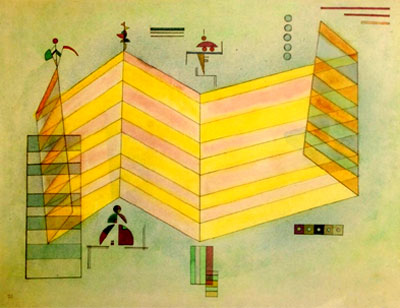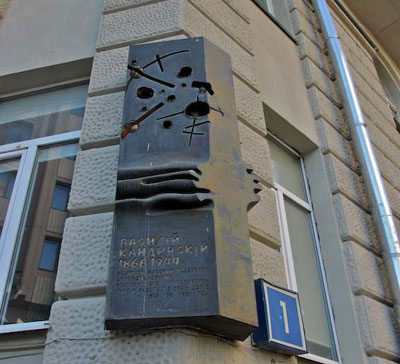|
For the 4th Anniversary of "Kandinsky Anew"
Re-introducing the Introduction
Lissa Tyler Renaud
In
April
of
2019,
I
wrote
my
first
piece
for
a
"Kandinsky
Anew"
Series
that
didn't
yet
exist,
and
the
next
month
made
it
official
with
"Introduction
to
the
Series."
That
piece
follows.
I
am
gratified
when
I
look
back
over
the
four
years.
This
is
the
49th
entry!
Entries
have
come
from
Belgium,
China,
France,
Germany,
Russia,
the
U.K.,
and
the
U.S.—western,
southern,
and
eastern.
Writers
have
been
working
artists,
thinkers,
and
scholars
both
new
and
known.
True to the Series' stated purpose, our pieces have gone beyond painting to focus on Kandinsky's contributions to the theatre, poetry, music, acting, dance, and architecture. There is nothing here that you will find elsewhere. Pieces have included first-person and behind-the-scenes accounts; topics as broad as Kandinsky's little or unknown history, biography, impact, friendships; first publications and first English translations. This breadth has also kept the Series current: I had at the ready an older piece on China to repeat when the media began to "pioneer" U.S./China tensions, and another on Totalitarianism as it emerged with new vigor just over one year ago.
You can see the four years of pieces in one place in the Special Index, here.
Thank
you
to
Arthur
Danin
Adler,
editor-in-chief extraordinaire,
for
making
a
place
for
this
Series
in
his Scene4 "print magazine online," and to Readers for their warm interest and fine messages.
When
you
read
"Introduction
to
the
Series,"
ask
yourself
whether
you
have
new
perspectives
on
Kandinsky,
whether
you
know
Kandinsky
anew.
Oakland, California
April 2023
*
"Kandinsky Anew": Introduction to the Series
Curated and Edited by
Lissa Tyler Renaud
Introduction
This
Introduction
is
the
first
entry
for
my
new
series
in
Scene4,
entitled
Kandinsky
Anew.
It
is
dedicated
to
new
perspectives
on
Kandinsky's
"life
in
art,"
mostly
beyond
painting—with
emphasis
in
the
fields
of
theatre,
poetry,
music,
dance
and
architecture,
and
on
other
topics
that
contribute
to
our
seeing
Kandinsky
anew.
In
2017,
I
started
actively
gathering
and
requesting
professional,
historical,
and
other
thoughtful
writings
on
Kandinsky's
wide-ranging
works,
activities,
and
thinking.
The
resulting
pieces—by
artists
and
researchers,
practitioners
and
close
observers—form
a
lively,
expansive,
and
challenging
collection
of
essays
and
articles.
Along
with
creating
a
kind
of
repository
for
significant
new
materials
on
Kandinsky,
the
pieces
for
Kandinsky
Anew
are
also
selected
to
interest
and
surprise
the
general
public's
multitudes
of
Kandinsky
aficionados.
Readers
of
Scene4
saw
a
successful
"test
balloon"
for
this
idea
in
the
April
2019
issue:
my
interview
about
Kandinsky
with
the
eminent
Peter
Selz, Still "Mr. Modern Art" at 100.
Over
the
years,
Kandinsky
studies
have
thrived
under
the
care
of
a
tight-knit
group
of
intrepid
scholars
who
publish
and
confer.
But
Kandinsky
seems
to
me
to
be
everywhere.
In
my
reading,
for
example,
his
name
appears
unexpectedly
in
books
on
a
wide
range
of
topics:
philosophy,
popular
science,
physics,
neuroscience,
history,
Asian
studies,
in
personal
memoirs
of
people
in
far-flung
places,
and
more.
Then,
too,
I
know
more
than
a
few
people
who
are
neither
scholars
nor
authors
evoking
Kandinsky's
name,
but
who
nevertheless
offer
important
perspectives,
being
among
the
most
interesting
thinkers
on
Kandinsky,
having
dedicated
much
rumination
to
the
deeper
meanings
of
his
life
and
work.
I
am
delighted
to
feature
their
writings
in
Kandinsky
Anew.
As
we
all
know,
the
Internet
is
a
curse
and
a
blessing.
On
the
one
hand,
non-specialists
and
specialists
alike
have
spread
a
narrow
version
of
Kandinsky,
rife
with
misinformation,
some
of
it
scurrilous.
Did
he
play
the
violin,
break
with
his
parents
on
becoming
an
artist,
was
he
a
devotee
of
theosophy,
was
he
anti-Semitic,
was
he
tragically
isolated
in
Paris?
No;
all
no.
On
the
other
hand,
the
Internet
allows
us
access
to
rich
materials,
even
global
ones,we
could
not
otherwise
see:
documents,
articles,
videos,
visual
resources.
This
has
changed
the
way
Kandinsky
can
be
studied
and
understood,
and
you
are
likely
to
find
pieces
based
on
an
unusual
selection
of
these.
*
In 2000, I wrote in a column about Kandinsky for Scene4:
I
was
very
much
struck
over
twenty
years
ago
when
I
came
across
a
remark
made
by
Chaliapin
(d.
1938),
the
great
Russian
basso.
He
said
that
he
had
learned
more
about
acting
from
his
friends
who
were
painters
than
he
ever
did
from
stage
actors.
Around
the
same
time,
I
also
stumbled
on
an
anecdote
that
seemed
to
me
to
be
related:
when
a
young
Martha
Graham
saw
a
non-figurative
painting
of
Kandinsky's
in
1922
she
is
said
to
have
said,
"I
will
dance
like
that."Comments
such
as
these
seem
to
me
to
be
fruitful
areas
of
inquiry;
clearly
the
fine
arts
have
something
to
say
to
the
performing
arts.

"Now Upwards!" 1931
Watercolor, wash and ink on paper, 48.1 X 61 cm.
The Hilla von Rebay Collection
Indeed, Kandinsky the painter had a great deal to say to the performing
arts. From my perspective as a theatre practitioner and scholar as well as
an art historian, it is ironic that Kandinsky's long-time, stage-related work
receives more attention from outside the field of theatre than inside it.
More than anything, this speaks to the theatre's historically fitful
relationship with its avant-garde. Kandinsky's contributions to the stage
are every bit as revolutionary as his contributions to painting, but have
never been seriously mined for their treasures. Note that Kandinsky was
well-read in both classical and contemporary dramatic literature (Goethe,
Kleist, Ibsen, Chekhov, Maeterlinck, et alia), and well aware of
experimenters of his time, such as Isadora Duncan, Dalcroze, and far
beyond. His messages to the theatre still await the level of legitimacy from
the theatre that they receive elsewhere. And the same can be said of his
historic contributions in other fields, too.
*
All re-constructions of history are connect-the-dots endeavors. In
Kandinsky's history, some connectable dots are missing altogether; some
"dots," pieces of information or contexts, are still hidden or passed
over—matters without which the true picture of his life and work remains
partial.
Kandinsky's years in Russia, from the outbreak of WWI to his joining the
German Bauhaus in 1922, have been a somewhat weak link in our
knowledge. Compared to information about his time in Germany and
France, information about his "Russian Years" has been far less freely
available to us. This has gradually changed in the years since the December
1991 dissolution of the Soviet Union.
And thereby hangs a tale from my own experience. When I began my
formal doctoral studies of Kandinsky in the early 1980s, Kandinsky was
little known inside Russia. To see a stage work of his, it was to Germany I
went, to see the reconstruction of his Dessau staging of "Pictures at an
Exhibition." Materials pertaining to his work and life in Russia—still
incomplete today for various reasons—circulated tenderly among devotees,
in hit-or-miss translations, sometimes at great expense or arriving in the
mailbox in dog-eared photocopies from distant countries. Russian
speakers in the West were luckier, but for the rest of us, by expanding
one's search farther and farther afield, one could collect quite an
impressive amount of clandestine documentation. Then in Moscow, in
January of 1991, I saw one of the first exhibitions of the avant-garde artists
who had fallen foul of official ideology after the 1917 Revolution, and
whose work—including Kandinsky's—had been thereafter unknown.
On that same 1991 trip, with my translator in tow, I knocked on the door of
Kandinsky's Moscow apartment and was greeted by a quite ordinary tenant
who claimed not to know Kandinsky's name. On the way down the stairs,
to my astonishment I could see where someone had tentatively removed a
small area of paint on the wall, below eye level and partly obscured by a
hand railing, exposing what was clearly Kandinsky's folk-style decorative
painting underneath. It took several more years before the word was out,
and there were efforts made to preserve that same painted wall and others
on the stairwell, as well as to add to the building's exterior a beautiful
plaque stating that Kandinsky had lived there:

By 2010, when I gave a talk on Kandinsky's theatre works and poetry at the
St. Petersburg State Theatre Arts Academy (now the Russian State Institute
of Performing Arts), the difference was palpable. My audience was hearing
the information for the first time, but afterwards, there was eager
discussion, and an invitation to give an impromptu class on Kandinsky's
spatial analysis for directors and actors in the Advanced Directing Studio.
Where Kandinsky is concerned, certainly we are now collectively in a
different era of understanding than we were in the 1980s or '90s.
*
Today, Kandinsky's theatre and other work outside of painting is the
subject of fascination in countries around the world, generating not only
conferences, publications, and dissertations, but also exhibits, stage works,
collaborations, discussions and friendships. Hopefully, the writings for
Kandinsky Anew can give the world new perspectives on Kandinsky,
covering a dynamic spectrum of historical and creative thought by
theoreticians, practitioners, and thinkers—multi-disciplinary, multi
-generational, and multi-national.
Wishing you a reading experience as unconventional and adventurous as
Kandinsky himself was.
Lissa Tyler Renaud
Oakland, California, April 2019
Cover Image behind type:
"A Fluttering Figure" 1942, oil on wood
26 X 20 cm. Pompidou Center
Note: An earlier, different version of this article was
developed for Dramaturgias journal, Brazil.
|